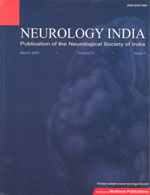
|
Neurology India
Medknow Publications on behalf of the Neurological Society of India
ISSN: 0028-3886
EISSN: 0028-3886
Vol. 52, No. 3, 2004, pp. 346-349
|
 Bioline Code: ni04113
Bioline Code: ni04113
Full paper language: English
Document type: Research Article
Document available free of charge
|
|
|
Neurology India, Vol. 52, No. 3, 2004, pp. 346-349
| en |
Spectrum of intracranial subdural empyemas in a series of 45 patients: Current surgical options and outcome
Tewari ManojK, Sharma RewatiR, Shiv VinodK, Lad SantoshD
Abstract
Background:
The subject of subdural empyema (SDE) is reviewed on the basis of experience with 45 cases.
Methods:
Records of 45 patients with SDE were analyzed. There were 35 males and 10 females in the series. The majority of the patients were either infants (22.2%) or in their second and third decade of life (37.8%). For supratentorial SDE, craniotomy was done in 5 cases (11.1%). In six cases (13.3%) two burr-holes and in the rest of the cases multiple burrholes were done to evacuate the empyema. Craniectomy was done in three cases (6.7%), of which two had posterior fossa SDE. All patients received appropriate preoperative and postoperative broad-spectrum antibiotics.
Results:
There was good recovery in 35 (77.8%) patients, six patients (13.3%) had moderate disability, two patients (4.4%) had severe disability, and two (4.4%) died. Three patients who developed recollection at operation site required evacuation of residual SDE. Median follow-up was 3½ years (range 4 months to 3½ years).
Conclusion:
Emergent evacuation of SDE using multiple burr-holes and irrigation of the subdural cavity with saline for 24 hours results in a satisfactory outcome in cases with SDE.
Keywords
Subdural hemorrhage, surgery, burr hole, treatment outcome
|
| |
© Copyright 2004 Neurology India.
Alternative site location: http://www.neurologyindia.com
|
|
